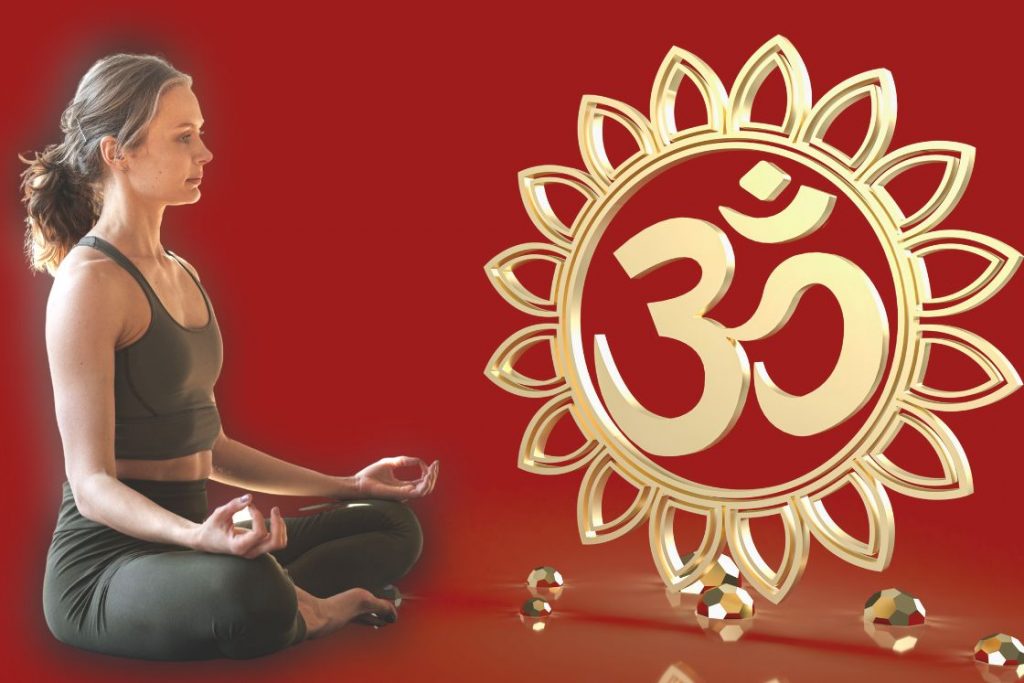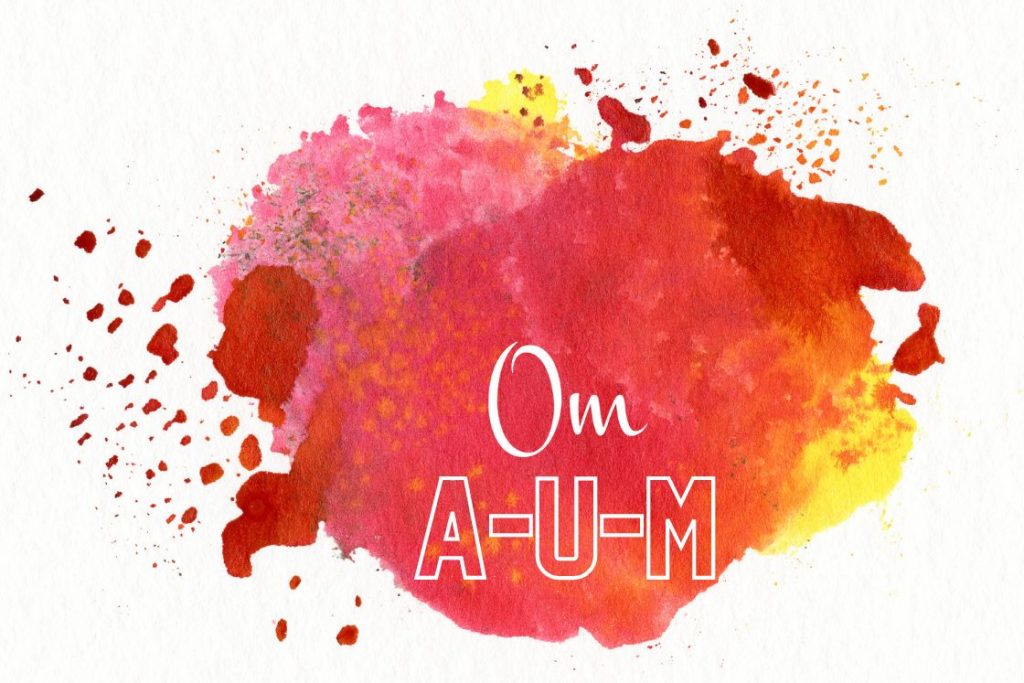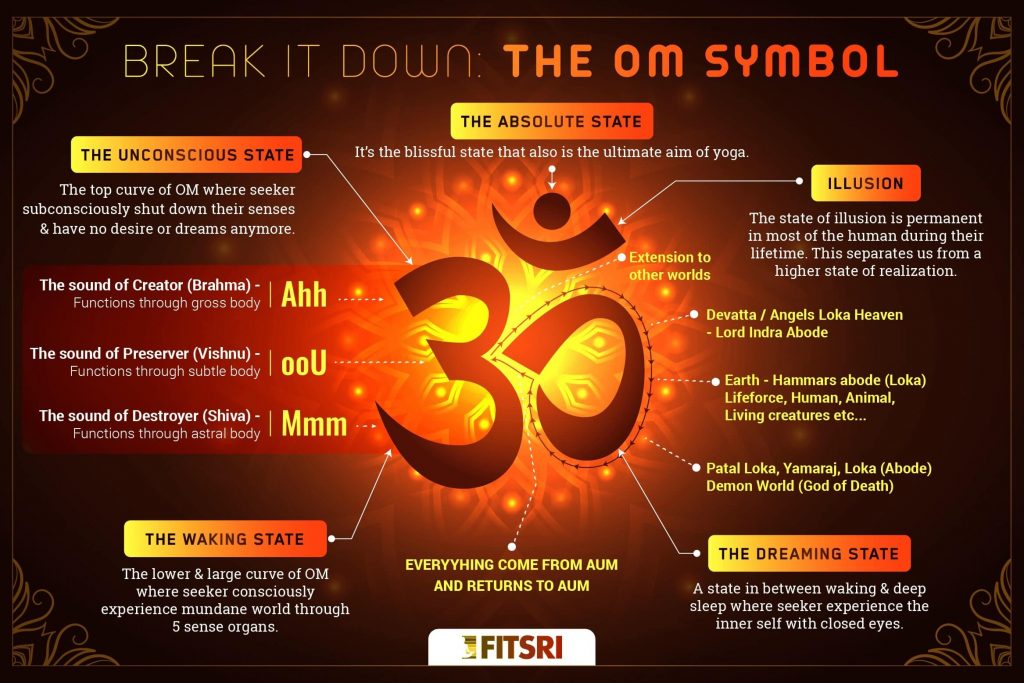
If you have been into yoga for some time, chances are, one way or another, you know about Om. OM is a symbol with sacred meaning in Hinduism as well as a seed mantra.
As a common mantra in yoga, OM is chanted usually at the beginning and/or the end of the yoga class. In your checklist for the first yoga class, be prepared for chanting OM in the group at least once or twice in a session.
All of the vibrations in the cosmos are included in the sound of OM. Calming you down, bringing you happiness, and igniting your spirituality, OM chanting can help you connect with higher consciousness.
Did you ever realize if you’re chanting OM correctly? Do you incorporate nose and mouth breathing separately during inhale and exhale in OM? Do you focus on different parts of the body while reciting different sounds of OM? Yes, this is how OM chanting actually should be.
Chanting OM, however, seems to sound like any other word we recite but in yoga, it is totally a different game. Because we incorporate breathing in a pattern while OM chanting, it’s also practised separately as pranayama called “Udgeeth Pranayama / OM chanting breath“.
In this article, we will see the correct way of chanting OM. Before that, it’s important to know how we utter different sounds of OM separately and what is their significance on the physical, mental and spiritual planes.
Understanding the sound of OM
When we speak a word, be it in any language, we use a specific part of our mouth to make a sound. For example, when we say ‘K’; we are using our throat, when we say ‘d’; we touch the upper palate with our tongue, and in pronouncing ‘b’; we purse our lips.
Keeping this in mind, OM is considered to be a complete word in itself as you utilize each part of your mouth yet your tongue remains untouched when you utter it.

The syllable Om is composed of the three sounds ‘A’, ‘U’ and ‘M’ – AUM. Literally, it’s pronounced as “AaaahooohMmmm.” When we chant OM, we take a deep breath in and while breathing out slowly, chanting starts with the sound ‘Aaaaah’ produced from the deep throat, gradually shifting to “oooh” from the middle part of the mouth and finally ends at “Mmmm” through the front part of the mouth.
All three sound of Om is chanted from the mouth during one exhalation. It signifies the emergence, sustenance, and completion; combinedly known as the “original vibration of the universe” in Hinduism.
The first sound “Aaaah”
While Om is chanting, the back of the throat will be the first part from where the word “A” is produced, sounding like a drawn-out “awe.”
When pronounced correctly, “Aaaah” creates vibrations in the lower abdomen and the lower three chakras – Muladhara, Svadhisthana and Manipura. This sound affects the spinal cord and increases its efficiency.
To pronounce this, inhale deeply and as you exhale; open your mouth wide keeping the tongue in the empty space between the upper and lower palate pronounce “Aaaaah” from the back of your throat. Extend the sound till your chest and solar plexus chakra start to vibrate. Feel your stomach slowly going inwards as the sound reaches its completion.
The second sound “oooh”
The emission of the sound of the word U, which is pronounced as a lengthy “oooh,” is a natural continuation of the first sound “Aaaah.”
Continuing the sound “Aaaah”, gradually shift your pronunciation to “oooh” coming from the upper palate. Here, your mouth opening will narrow down to a horizontal ellipse shape automatically to accommodate this sound.
The sound of ‘U’ in AUM activates the middle region of the body including the heart chakra and throat chakra. It affects the thyroid and parathyroid glands.
The third sound “Mmmmm”
The sound of the third syllable, M, is a long “Mmmm.” It ends with a pause of silence. This sound creates vibration in the head region, nose and upper two chakras – Ajna and Sahasrara.
Continuing the sound “oooh”, gently seal your lips, tongue touching the front teeth; start pronouncing the “Mmmm” sound coming from the front part of your mouth. Feel the vibrations slowly blending into silence.
How to chant OM correctly
Om chanting is normally done at the beginning of meditation. Therefore, the ideal time to chant is the early morning when there is natural calmness in the environment.
Most commonly Om is chanted three times during prayers, rituals or any religious practice. However in meditation and when it’s chanted as a standalone practice, Om chanting should be done 21 or 108 times. It’s considered auspicious numbers in the yogic tradition.
Learn more: Why do we practice sun salutation 108 times
Set a time for chanting so that your mind is not constantly distracted by thinking you have lost track of time. Generally, It will take 10 or 30 minutes to complete 21 or 108 chants respectively. You can use a timer for 5,10,15 minutes, with a soft sound to alert you.
Before you begin Om chanting, find a quiet place where no one can disturb you for your intended period of time. If you are chanting in your home at a room, tell your family members of your intentions and not disturb you.
Sit down in a crossed-leg meditation position that you find comfortable. A beginner can sit in Sukhasana (easy pose). Whatever position you choose, make sure you keep your spine and back of the head straight and aligned. Your chest should be open and your chin parallels the ground.
One can choose to sit on a chair as well. Your feet should be in direct contact with the floor and your spine erect throughout the practice.
Bring your hands on your knees palm facing up. Make Gyan mudra with both your hands and close your eyes for meditation. Relax your mind and body by bringing your attention to the breath. Throughout the chanting, focus your mind on the sound and synchronize this sound with your breath.
Follow the steps to chant om correctly:
- Take three deep breaths slowly and steadily through your nose.
- At the end of the third inhale as you exhale, open your mouth and chant the “Aaaah” from your throat. Feel the sensation of vibration in the lower abdomen region.
- In the same breath, slowly narrow your mouth opening and gradually shift your chant to the “oooh” sound coming from the upper palate. Here, feel the vibration rising from chest to throat region. Combindelly the word ‘A-U’ will create ‘Aaaaaaooooh’ sound.
- Maintaing this same breath, slowly seal your lips keeing upper and lower teeth slightly parted, and shift your chant to “Mmmmmm…ng” sound coming front part of your mouth. Transition from “oooh” sound to “Mmmm” will be natural.
- Be in the silence for a few seconds after one Om chant ends with “Mmmmmm…ng” sound.
- Inhale through nose and repeat the process with “Aaaaah” chant.
- Chant in this manner 3 times in the beginning if you’re doing it yourself. With time and practice, extend the number of chants to 9, 21 and 108 times.
After completing Om chant 3 times initially, observe your breathing. If you’ve chanted correctly, you will see in your natural breathing the exhalation is little longer than inhalation. It shows the activation of parasympathetic or ‘rest-and-digest’ system of the body.
Remember these points while OM chanting
- Do not focus on sound of A-U-M altogether initially. Go with the flow and chant specific word sound separately, combinedly it will create the sound of Om.
- Transition from ‘A to U’ and ‘U to M’ sound should be gradual and steady that even you don’t realize it. Try to not break the chant when shifting one word’s sound to another.
- Do not strain your breathing to extend your chant. Divide one breath in a manner that sound of ‘A-U’ takes 80 percent of your breath and the sound of ‘M’ rest 20 percent .
- While in group chanting of Om, like in a yoga class, blend your voice with everyone in the group.
- Most importantly, do not be conscious of how you chant Om. Focus on how the chant makes you feel and merge into the vibration of the chant.
Silent chanting of OM
Silent chanting or mental chanting of OM is considered the highest form of chanting. It places a direct impact on the higher chakras and mind. It encourages you to explore yourself inwards with an awareness of the breath.
When you chant silently, you will notice that AUM is synchronized with your inhale and exhale automatically.
To chant OM silently, come to the same position as you would for regular meditation. Place your palms on your knees and close your eyes. Keep your body steady and inhale deeply three times. Give it a minute or two more to allow your mind to relax. Begin chanting the Om mantra in your mind. When you are meditating silently, you don’t need to move your lips.
The pronunciation of the OM mantra should remain the same as you would when chanting loudly. Your mind will naturally get quiet as you continue forward with it. As soon as you bring your attention to the stillness of your mind, thoughts will begin to return. Continue your practice without giving it any thought.
Silent chanting urges you to understand your root of existence by going into the subconscious mind. You can get a clear picture of the age-old question of “Who am I?” and “What am I?”
The biggest benefit of silent chanting is that you can perform it anywhere, anytime, and in any situation.
Significance of OM chanting

Spiritually speaking, symbol OM has a very special and high significance in Hinduism. It is considered to be the word that was produced at the time of the creation of the universe. Thus, OM contains vibrations (432 Hz) similar to that of the universe and nature in itself. Chanting OM means you are making a connection to the universe and nature in its purest form.
This is also the reason most ancient Hindu texts and mantras start with and end with OM.
In yogic traditions, OM is often chanted at the beginning and end of a practice. It is a bija mantra that signifies the Atman (soul) and the Brahman (universe, truth, or ultimate reality).
According to sage Patanjali, chanting OM in the proper way can sharpen and deepen the meditation practice and elevate our consciousness. You can also be free from your karmic debts if you chant OM regularly with dedication.
Your chakras are also stimulated and cleansed with the vibrations of OM chanting.
It starts with the Solar Plexus chakra, gradually spreads to the Heart, Throat, and Third Eye chakra, and ends at the Crown chakra. If you put your hands in each of these locations, you can easily feel these vibrations. A much more profound vibration can be felt in the third eye and crown chakras which are located in the head.
There are also various meanings of OM or AUM. In nature, A signifies the awake state, U is the dreaming state and M is the state of deep sleep. It is also sometimes associated with the Lord Ganesha, where A is his belly, U is the trunk and M is his head.
Moreover, the three significant Gods in the Hindu religion Brahma, Vishnu, and Shiva are also said to be represented by AUM.
Frequently Asked Questions
While there is no definitive duration for mantra chanting, start by setting 5 minutes initially for a few days. For mantra meditation, you can increase the time to 30 minutes to 1 hour.
Generally Om is chanted three times at the start and ending of yoga class. It’s either combined with 3 Shanti’s of shanti mantra or chanted separately.
As a spiritual seeker, one can chant Om 21 times. Chanting Om 21 times purifies 5 organs of action, 5 organs of perception, 5 vayus, 5 koshas and person’s ego.
OM is a bija mantra that can be chanted at any time and for any situation. However, the best time to chant is during the Brahma Muhurta (between 4-6 am), 12 noon, and in the evening, as they are considered auspicious times. These are also the times when you can experience a certain level of quietness.
When Om is chanted three times, breathing ratio should be like this;
First time: A sound – 50%, U sound – 30% and M sound – 20%
Second time: A sound – 30%, U sound – 30% and M sound – 40%
Third time: A sound – 20%, U sound – 30% and M sound – 50%





you state: As a spiritual seeker, one can chant Om 21 times. Chanting Om 21 times purifies
5 organs of action
5 organs of perception
5 vayus
5 koshas and person’s ego
Which equals to 20. What is the final AUM for? I’ve been researching this but cant seem to find an answer. Please help. Thanks!
The final “AUM” in this context is typically chanted to represent the ultimate reality or the source of all existence, which transcends the 20 aspects you mentioned. It signifies the unity of all aspects and the connection to the divine or the higher self.